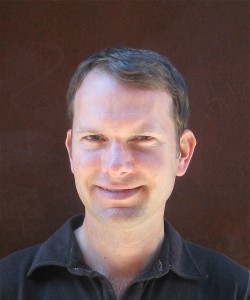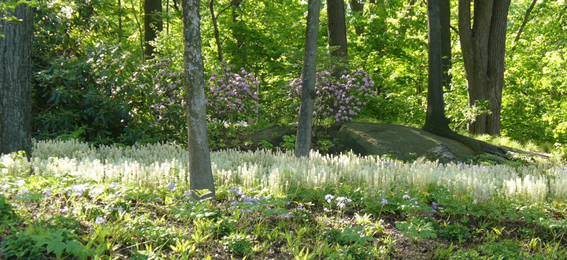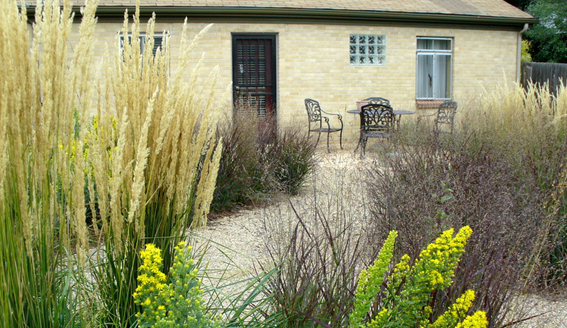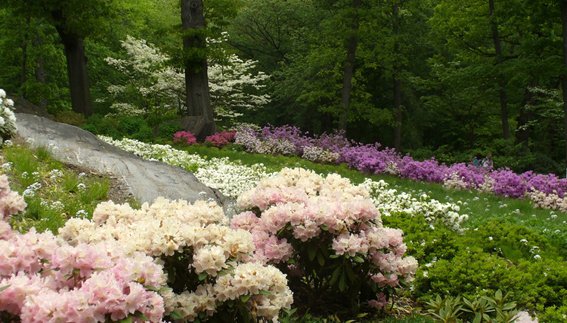Travis Beck: Rewriting Landscape Design
Posted in People on February 7 2013, by Matt Newman
 Travis Beck humbly recalls his first gratifying experience as a landscape designer, a xeriscape project he planted with his own company in Colorado. “It was a small border,” he says, “but we finished on time, on budget, and it grew in very nicely.”
Travis Beck humbly recalls his first gratifying experience as a landscape designer, a xeriscape project he planted with his own company in Colorado. “It was a small border,” he says, “but we finished on time, on budget, and it grew in very nicely.”
Years later, walking through the multi-tiered landscape of the Native Plant Garden, his ego still keeps to a small space–though his undertakings seldom do. The words Beck uses to describe his work are efficient and to-the-point, even as our tour group skirts the massive water feature he’s helped realize at the center of this latest NYBG revision. But his pragmatism has a purpose in this near fairytale landscape, just as it does in his recently published book: Principles of Ecological Landscape Design.
Not one to settle for the “green” aphorisms being passed along in today’s design industry, Beck’s book captures his approach to environmentally sound landscapes with practical examinations of the before, after, and in between of each project. Thoroughness is key and few aspects are left to chance. More than a simple source of inspiration, Principles of Ecological Landscape Design is a compendium designed to address every consideration for the professional or student designer. Plant selection, competition and coexistence, wildlife interaction, biodiversity, and stability are only a sampling of the many topics tackled.
But what of the hobbyist or home landscaper? I got hold of Travis to get a better idea of how he came to write this encyclopedic work, how his NYBG experience played into the final printing, and how lay audiences might benefit from picking it up. True to form, his responses cut straight to the point.

As one of the principle figures behind the redesigned Native Plant Garden–a huge project by almost any standard–you’re clearly working in the upper tier of your industry. When you first found your way into landscape design, were your intentions this grand in scope?
I first started in this line of work by growing organic vegetables. Then I moved into sustainable landscaping more generally. Maybe I’ve always felt that there’s a better way to do things, a way that recognizes the full potential of landscapes as living systems.
Was there a particular motivation behind Principles of Ecological Landscape Design that drove you to put pen to paper?
It seemed intuitive to me that a landscape that was modeled on nature would be successful, easy to care for, and good for the larger environment. I spent years looking for information on how to really do that, but I could only find partial answers to my questions. So I wanted to really think it through for myself, and I wanted to share what I found.
Of your years at The New York Botanical Garden, how much has your experience here influenced your book?
I’ve had the opportunity to work with really smart and experienced people here at the Garden, including designers such as Darrel Morrison, who contributed a case study to the book. We’ve gotten to try out some big ideas, such as creating a garden of entirely native plants, and restoring a stream to improve its habitat value. Whenever I wrote about something in the book I asked myself, “Would this really work?” The practical experience was a good counterbalance to lofty theories.

How would you say your new book sets itself apart from landscape design texts that have come before it?
This book is based on real ecological science, paired with stories of people who have applied that science in very practical ways.
What would you consider to be the greatest challenge to conscientious landscape design by today’s development standards?
New development has to be done thoughtfully from the beginning. You can’t put up a big box store surrounded by acres of parking and make it better with a few plants.
As mainstream development practices go, has accomplishing the goals of ecological landscape design gotten easier in recent years, or more difficult?
I think it’s getting easier all the time. People increasingly accept the aesthetics of ecological landscapes, and a lot of work has been done promoting more sustainable approaches to managing stormwater. The green building movement is also leaking out into the landscape more and more. It’s a great time to be talking about these ideas.

Of everything covered in your book, what can you predict will be the most influential trend in the industry moving forward?
Green infrastructure is an idea that is really picking up steam. Originally it meant all the parks, greenways, and natural areas within a city. Now it’s used to refer to how all of those areas can help manage rainwater, preventing flooding and improving water quality in streams and rivers. We just completed a green infrastructure project here at the Garden over by Twin Lakes.
Your book seems to assert that the devil really is in the details, tackling the behind-the-scenes minutia that go into both creating and maintaining a landscape. But your target audience is more professional. How would you address those who might be intimidated by the depth of your book?
I wrote the book so it could be read in a number of ways—all at once, or as individual pieces. I’d suggest using the index or picking a chapter to read the parts that are of interest. I think it’s true, though, that the devil is in the details. I tried to be clear without dumbing anything down.
For the benefit of the home owner, what do you think is the most necessary change needed to make residential landscaping more ecologically sound?
The challenge of residential landscaping from an ecological perspective is that you’re working on discrete plots of land. I think the best thing a homeowner can do is connect to something that’s nearby in a meaningful way. If you live up against some woods, plant some native trees and shrubs in your yard to help push out that edge. If you live near a stream, reduce the runoff from your property and make sure it flows through vegetation. If you are surrounded by pavement or thousands of square feet of lawn, then go ahead and plant a habitat garden. The birds and insects will be grateful, and it might serve as a nucleus for something more later.

Principles of Ecological Landscape Design is now available from Island Press. To see Travis Beck’s accomplishments at the NYBG, you need only visit the Garden and look around; his influence can be seen in installations throughout our 250-acre landscape. Visit this coming May to witness the reopening of our Native Plant Garden.

